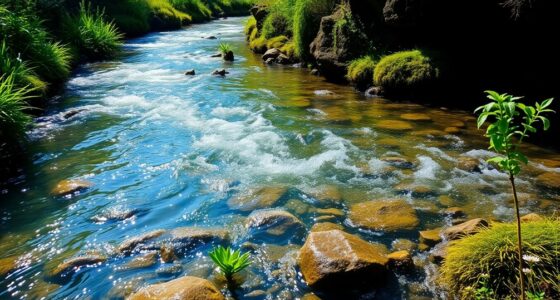The living desert shows how life can adapt to extreme conditions that seem impossible to survive. From scorching heat to scarce water, plants, animals, and microbes have developed remarkable strategies to endure. Understanding these adaptations reveals more than just survival; it offers lessons about resilience and resourcefulness. As you explore the ways life persists here, you’ll discover how nature’s tenacity can inspire solutions for challenging environments everywhere.
The Diversity of Desert Ecosystems
Have you ever wondered how diverse desert ecosystems really are? These landscapes aren’t just endless stretches of sand; they host a surprising variety of environments. You’ll find rocky plateaus, gravel plains, and dry riverbeds that support unique plant and animal communities.
Some deserts, like the Sonoran, are lush with cacti, shrubs, and thriving wildlife, while others, like the Atacama, are some of the driest on Earth, with minimal life. You might be surprised to learn that deserts exist on every continent, each with its own characteristics.
This incredible diversity shows that deserts aren’t lifeless wastelands but vibrant ecosystems, each adapted to their specific conditions, supporting a wide array of life forms. Creativity and problem-solving can also flourish in challenging environments, demonstrating the resilient nature of desert life.
Adaptations to Extreme Temperatures
Desert plants and animals have developed remarkable strategies to survive the extreme temperatures that characterize their environments. During scorching days, many animals seek shade or become inactive, conserving energy and avoiding heat stress.
Some animals, like the desert kangaroo rat, are nocturnal, foraging at night when temperatures drop. Others, such as cacti, have thick, waxy cuticles that reduce water loss and reflect sunlight.
Certain animals, like reptiles, bask in the sun to regulate their body temperature but retreat into burrows when it gets too hot. Plants often have deep root systems to access cooler, underground moisture or store water in thick stems.
These adaptations allow desert life to endure the relentless heat, maintaining vital functions despite the extreme temperatures.
Water Conservation Strategies
To survive the harsh conditions, desert plants and animals have perfected water conservation strategies that minimize water loss and maximize efficiency. You might notice animals limiting their activity to cooler parts of the day, reducing water evaporation. Many have specialized kidneys that concentrate urine, so they lose minimal water. Some plants store water in thick, fleshy tissues or have waxy coatings on their surfaces to prevent evaporation. You’ll also see animals with burrowing behaviors, staying underground during the hottest hours. Others have adaptations like scaled skin or hairy coverings that trap moisture and reduce transpiration. The choice of projector technology can also influence how well visual details are preserved, similar to how desert organisms adapt to maintain essential functions. These strategies allow desert creatures to thrive despite scarce water sources, ensuring they conserve every drop and survive in one of Earth’s most challenging environments.
Unique Plant Survival Tactics
Many desert plants have developed remarkable tactics to survive in extreme conditions. You’ll notice some plants, like cacti, store water in thick, fleshy stems, acting as reservoirs during droughts. Others, such as succulents, reduce water loss through specialized leaves or spines instead of broad leaves, minimizing surface area. You might see plants with deep root systems that penetrate far underground to access hidden moisture, or surface roots that rapidly absorb water from brief rains. Some plants, like desert grasses, have seeds that remain dormant until conditions are right, then sprout quickly to take advantage of fleeting water. Additionally, many desert plants have reflective surfaces or light-colored coatings that deflect sunlight. Incorporating water conservation techniques helps plants endure prolonged dry periods, ensuring their survival and reproduction. These tactics allow them to not only survive but thrive amid the harsh, arid environment.
Animal Survival in Arid Climates
How do animals thrive in such harsh, water-scarce environments? They’ve evolved remarkable adaptations to conserve and efficiently use water. Many animals, like desert foxes or rodents, stay active during cooler nights, avoiding daytime heat and water loss.
Some species have developed ethical considerations around conservation and habitat protection, which are crucial for their survival.
Some store fat in their bodies, which metabolizes into water when needed, like camels do with their hump fat. Others have specialized kidneys that concentrate urine, minimizing water loss.
Certain species, such as lizards, can absorb water through their skin or gather moisture from their food. Some animals, like rodents, burrow underground to escape the extreme heat and maintain humidity.
These strategies ensure they survive, reproduce, and thrive despite the extreme scarcity of water in arid climates.
Microbial Life in Harsh Conditions
Microbial life demonstrates incredible resilience, thriving in environments that would be deadly to most organisms. In deserts, you find microbes that survive extreme heat, intense UV radiation, and dehydration. These microorganisms have developed unique adaptations, like producing protective pigments that shield them from harmful rays or forming dormant spores during harsh periods. Some bacteria can fix nitrogen from the sparse atmosphere, supporting other life forms in nutrient-poor soils. Others break down toxic compounds, helping to detoxify their surroundings. Additionally, many microbes utilize digital sound synthesis to produce protective biofilms, enhancing their survival capabilities in extreme conditions. You mightn’t see these microbes, but they play vital roles in maintaining ecological balance. Their ability to endure such extreme conditions highlights life’s remarkable capacity to adapt and persist, even in the most inhospitable parts of the desert.
The Role of Soil and Microhabitats
Soil and microhabitats in desert environments create essential niches that support microbial life despite extreme conditions. These tiny ecosystems offer protection from the intense heat, UV radiation, and scarce water. AI safety measures are crucial in understanding and protecting these delicate environments from potential technological threats. Soil particles trap moisture, providing vital hydration for microbes, while organic matter offers nutrients that sustain them. Cracks and shaded microhabitats shield organisms from harsh sunlight and temperature fluctuations. Saline soils, though seemingly inhospitable, harbor specialized microbes that tolerate high salt levels. These microhabitats act as refuges, enabling microbes to survive and even thrive where conditions seem impossible.
Lessons From Desert Resilience
Desert ecosystems teach us valuable lessons about resilience and adaptation. You see, plants and animals here survive extreme conditions by evolving strategies that maximize resource use and minimize waste.
For example, cacti store water in thick stems, allowing them to endure long droughts. No matter how harsh the environment, desert species find ways to thrive—whether through deep roots that access underground water or nocturnal habits that avoid daytime heat.
These adaptations show that resilience isn’t just about surviving; it’s about thriving despite adversity. Studying these strategies reminds us that flexibility and innovation are vital in overcoming challenges. Furthermore, understanding the warning signs of a checked-out partner can help us recognize when emotional disconnection is undermining our resilience in relationships.
If desert life can flourish under such conditions, it offers valuable insights into resilience that you can apply in your own life.
Conclusion
You see how the desert’s vibrant life teaches us about resilience and adaptability. By observing its plants, animals, and microbes, you learn that survival isn’t just about enduring harsh conditions—it’s about thriving through clever strategies and resourcefulness. The desert shows you that even in the toughest places, life finds a way to flourish. Embracing these lessons can inspire you to overcome challenges and adapt creatively in your own life.





